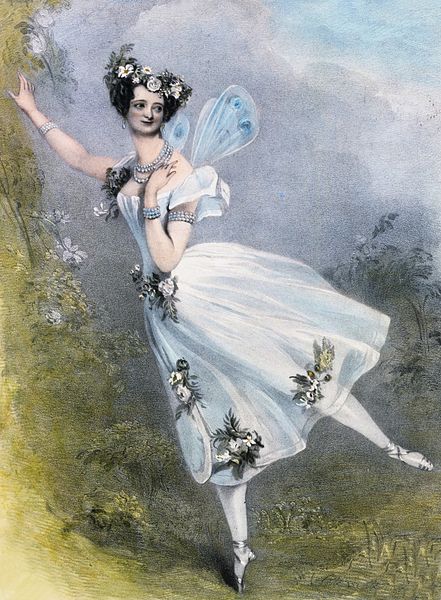Marie Taglioni, Comtesse de Voisins was a Swedish-born ballet dancer of the Romantic ballet era partially of Italian descent, a central figure in the history of European dance. She spent most of her life in the Austrian Empire and France. She was one of the most celebrated ballerinas of the romantic ballet, which was cultivated primarily at Her Majesty's Theatre in London and at the Théâtre de l'Académie Royale de Musique of the Paris Opera Ballet. She is credited with being the first ballerina to truly dance en pointe.
Taglioni in an 1839 lithograph
Lithograph by Chalon and Lane of Marie Taglioni as Flora in Didelot's Zéphire et Flore. London, 1831 (Victoria and Albert Museum/Sergeyev Collection)
Taglioni (center) in Pas de Quatre, 1845
Taglioni,ca 1845
The Romantic ballet is defined primarily by an era in ballet in which the ideas of Romanticism in art and literature influenced the creation of ballets. The era occurred during the early to mid 19th century primarily at the Théâtre de l'Académie Royale de Musique of the Paris Opera Ballet and Her Majesty's Theatre in London. It is typically considered to have begun with the 1827 début in Paris of the ballerina Marie Taglioni in the ballet La Sylphide, and to have reached its zenith with the premiere of the divertissement Pas de Quatre staged by the Ballet Master Jules Perrot in London in 1845. The Romantic ballet had no immediate end, but rather a slow decline. Arthur Saint-Léon's 1870 ballet Coppélia is considered to be the last work of the Romantic Ballet. Romantic ballet is believed to have been experienced in three main phases: The zenith phase from 1830-1840, the decline phase from 1850-1880, and the revival phase in the 1890s prior to Diaghilev. Each phase is synonymous with the production of a few specifically stylized ballets.

The Three Graces: embodiment of the Romantic ballet, ca. 1840. This lithograph by A. E. Chalon depicts three of the greatest ballerinas in three of the era's defining roles: (left to right) Marie Taglioni as the Sylph in Filippo Taglioni's 1832 ballet La Sylphide; Fanny Elssler as Florinda in the dance La Cachucha from Jean Coralli's 1836 ballet Le Diable boiteux; and Carlotta Grisi as Béatrix in the Grand pas de Diane chasseresse from Albert's 1842 ballet
Lithograph by A. E. Chalon of Carlotta Grisi (left), Marie Taglioni (center), Lucille Grahn (right back), and Fanny Cerrito (right front) in the Perrot/Pugni Pas de Quatre, London, 1845. The premiere of the Pas de Quatre is considered to be the Romantic ballet at its zenith.
A romantic tutu







